User:Godot13/List of United States Silver Certificates
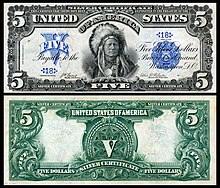
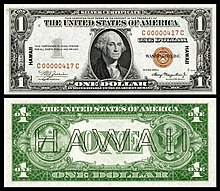
Silver certificates are a type of representative money issued between 1878 and 1964 in the United States as part of its circulation of paper currency.[1] They were produced in response to silver agitation by citizens who were angered by the Fourth Coinage Act, which had effectively placed the United States on a gold standard.[2] The certificates were initially redeemable for their face value of silver dollar coins and later (for one year – 24 June 1967 to 24 June 1968) in raw silver bullion.[1] Since 1968 they have been redeemable only in Federal Reserve Notes and are thus obsolete, but still valid legal tender.[1]
Large-size silver certificates (1878 to 1923) were issued initially in denominations from $10 to $1,000 (in 1878 and 1880)[3][4] and in 1886 the $1, $2, and $5 were authorized.[4][5] In 1928, all United States bank notes were re-designed and the size reduced.[6] The small-size silver certificate (1928-1964) was only issued in denominations of $1, $5, and $10.[7]
History
[edit]The Coinage Act of 1873 intentionally[8][9] omitted language authorizing the coinage of “standard”[2] silver dollars[10] and ended the bimetallic standard[11] that had been created by Alexander Hamilton.[12][nb 1] While the Coinage Act of 1873 stopped production of silver dollars, it was the 1874 adoption of Section 3568 of the Revised Statutes that actually removed legal tender status from silver certificates in the payment of debts exceeding five dollars.[14] By 1875 business interests invested in silver (e.g., Western banks, mining companies) wanted the bimetallic standard restored. People began to refer to the passage of the Act as the Crime of '73. Prompted by a sharp decline in the value of silver in 1876, Congressional representatives from Nevada and Colorado, states responsible for over 40% of the world’s silver yield in the 1870s and 1880s,[15] began lobbying for change. Further public agitation for silver use was driven by fear that there was not enough money in the community.[16] Members of congress claimed ignorance that the 1873 law would lead to the demonetization of silver,[17] despite having had three years to review the bill prior to enacting it to law.[18] Some blamed the passage of the Act on a number of external factors including a conspiracy involving foreign investors and government conspirators.[10]
In response, the Bland–Allison Act, as it came to be known, was passed by Congress (over a Presidential veto)[19] on February 28, 1878. It did not provide for the "free and unlimited coinage of silver" demanded by Western miners, but it did require the United States Treasury to purchase between $2 million and $4 million of silver bullion per month[20][21] from mining companies in the West, to be minted into coins.[nb 2]
Large-size silver certificates
[edit]The first silver certificates (Series 1878) were issued in denominations of $10 through $1,000. [nb 3] Reception by financial institutions was cautious.[24] While more convenient and less bulky than dollar coins, the silver certificate was not accepted for all transactions.[25] The Bland–Allison Act established that they were “receivable for customs, taxes, and all public dues,”[19] and could be included in bank reserves,[21] but silver certificates were not explicitly considered legal tender for private interactions (i.e., between individuals).[21] Congress used the National Banking Act of 12 July 1882 to clarify the legal tender status of silver certificates[26] by clearly authorizing them to be included in the lawful reserves of national banks.[27] A general appropriations act of August 4, 1886 authorized the issue of $1, $2, and $5 silver certificates.[5][28] The introduction of low-denomination currency (as denominations of U.S. Notes under $5 were put on hold) greatly increased circulation.[29]
Over the 12-year lifespan of the Bland–Allison Act, the United States government would receive a seigniorage amounting to roughly $68 million (between $3 and $9 million per year),[30] while absorbing over 60% of U.S. silver production.[30]
Small-size silver certificates
[edit]Treasury Secretary Franklin MacVeagh (1909–13) appointed a committee to investigate possible advantages (e.g., reduced cost, increased production speed) to issuing smaller sized United States banknotes.[31] Due in part to the outbreak of World War II and the end of his appointed term, any recommendations may have stalled. On 20 August 1925, Treasury Secretary Andrew W. Mellon appointed a similar committee and in May 1927 accepted their recommendations for the size reduction and redesign of U.S. banknotes.[31] On 10 July 1929 the new small-size currency was issued.[32]
In response to the Japanese attack on Pearl Harbor, the Hawaii overprint note was ordered from the Bureau of Engraving and Printing on 8 June 1942.[32] Issued in denominations of $1, $5, $10, and $20, only the $1 was a silver certificate, the others were Federal Reserve Notes.[33] Stamped “HAWAII” (in small solid letters on the obverse and large letters on the reverse), with the Treasury seal and serial numbers in brown, these notes could be demonetized in the event of a Japanese invasion.[34] Additional World War II emergency currency was issued in November 1942 for circulation in Europe and Northern Africa.[32] Printed with a bright yellow seal, these notes ($1, $5, and $10) could be demonetized should the United States lose its position in the European or North African campaigns.[33]
End of the silver certificates
[edit]In the nearly three decades since passage of the Silver Purchase Act of 1934, the annual demand for silver bullion rose steadily from roughly 11 million ounces (1933) to 110 million ounces (1962).[35] The Acts of 1939 and 1946 established floor prices for silver of 71 cents and 90.5 cents (respectively) per ounce.[35] Predicated by an anticipated shortage of silver bullion,[36][37] Public Law 88-36 (PL88-36) was enacted on 4 June 1963 which repealed the Silver Purchase Act of 1934, and the Acts of 6 July 1939 and 31 July 1946,[38] while providing specific instruction regarding the disposition of silver held as reserves against issued certificates and the price at which silver may be sold. [nb 4] It also amended the Federal Reserve Act to authorize the issue of lower denomination notes (i.e., $1 and $2),[38] allowing for the gradual retirement (or swapping out process) of $1 silver certificates and releasing silver bullion from reserve.[37] In repealing the earlier laws, PL88-36 also repealed the authority of the Secretary of the Treasury to control the issue of silver certificates. By issuing Executive Order 11110, President John F. Kennedy was able to continue the Secretary’s authority.[39] While retaining their status as legal tender, the silver certificate had effectively been retired from use.[32]
In March 1964, Secretary of the Treasury C. Douglas Dillon halted redemption of silver certificates for coined silver dollars; during the following four years, silver certificates were redeemable in uncoined silver "granules."[36] All redemption in silver ceased on June 24, 1968.[1]
Issue
[edit]Series and varieties
[edit]| Series | Value | Features/varieties |
|---|---|---|
| 1878 and 1880 |
$10 $20 $50 $100 $500 $1,000 |
In addition to the two engraved signatures customary on United States banknotes (the Register of the Treasury and Treasurer of the United States), the first issue of the Series 1878 notes (similar to the early Gold Certificate) included a third signature of one of the Assistant Treasurers of the United States (in New York, San Francisco, or Washington DC).[40] Known as a countersigned or triple-signature note, this feature existed for the first run of notes issued in 1880, but was then removed from the remaining 1880 issues.[4] |
| 1886 | $1 $2 $5 $10 $20 |
The Act of 4 August 1886 authorized the issue of lower denomination ($1, $2, and $5) silver certificates. Similar to the Series 1878/1880 notes, the Treasury seal characteristics (size, color, and style) varies with the change of the Treasury signatures. The series is known for the ornate engraving on the reverse of the note. |
| 1891 | $1, $2 $5, $10 $20, $50 $100 $1,000 |
The Bureau of Engraving and Printing introduced the process of “resizing” paper for Series 1891 notes.[41] |
| 1896 | $1 $2 $5 |
The Educational Series is considered to be the most artistically designed bank notes printed by the United States.[4] |
| 1899 | $1 $2 $5 |
Large-size silver certificates from the Series of 1899 forward have a blue Treasury seal and serial numbers. |
| 1908 | $10 | |
| 1923 | $1 $5 |
Large-size United States silver certificates (1878-1923)
[edit]| Value | Series | Fr.[nb 5] | Image | Portrait | Signature & seal varieties[nb 6] |
|---|---|---|---|---|---|
| $1 | 1886 | Fr.217 | 
|
Martha Washington | 215 – 221 215 – Rosecrans and Jordan – small red, plain. |
| $1 | 1891 | Fr.223 | 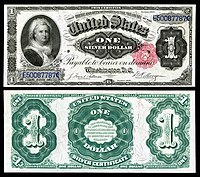
|
Martha Washington | 222 – Rosecrans and Nebecker – small red, scalloped. |
| $1 | 1896 | Fr.224 | 
|
Allegory History Instructing Youth (obv); George Washington & Martha Washington (rev) | 224 – Tillman and Morgan – small red, rays. |
| $1 | 1899 | Fr.226 | 
|
Abraham Lincoln & Ulysses Grant | 226 – 236 226 – Lyons and Roberts – blue. |
| $1 | 1923 | Fr.239 | 
|
George Washington | 237 – Speelman and White – blue. |
| $2 | 1886 | Fr.242 | 
|
Winfield Scott Hancock | |
| $2 | 1891 | Fr.246 | 
|
William Windom | 245 – Rosecrans and Nebecker – small red. |
| $2 | 1896 | Fr.247 | 
|
Allegory of Science Presenting Steam and Electricity to Commerce and Manufacture (obv); Robert Fulton & Samuel F.B. Morse (rev) | 247 – Tillman and Morgan – small red. |
| $2 | 1899 | Fr.249 | 
|
George Washington | 249 – 258 249 – Lyons and Roberts – blue. |
| $5 | 1886 | Fr.264 | 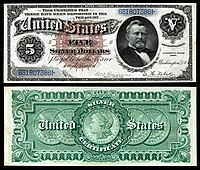
|
Ulysses Grant | 259 – 265 259 – Rosecrans and Jordan – small red, plain. |
| $5 | 1891 | Fr.267 | 
|
Ulysses Grant | 266 – Rosecrans and Nebecker – small red, scalloped. |
| $5 | 1896 | Fr.270 | 
|
Allegory of Electricity Presenting Light to the World (obv); Ulysses Grant & Philip Sheridan (rev) | 268 – Tillman and Morgan – small red. 269 – Bruce and Roberts – small red. |
| $5 | 1899 | Fr.271 | 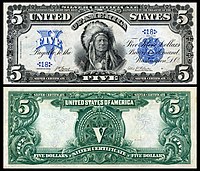
|
Running Antelope | 271 – 281 271 – Lyons and Roberts – blue. |
| $5 | 1923 | Fr.282 | 
|
Abraham Lincoln | 282 – Speelman and White – blue. |
| $10 | 1878 | Fr.285a* | 
|
Robert Morris | 283 – 285a 283 – Scofield and Gilfillan, CS by W.G. White – large red. |
| $10 | 1880 | Fr.287 | 
|
Robert Morris | 286 – 290 286 – Scofield and Gilfillan, CS by T. Hillhouse – large brown with X. |
| $10 | 1886 | Fr.291 | 
|
Thomas Hendricks | 291 – 297 291 – Rosecrans and Jordan – small red, plain. |
| $10 | 1891 | Fr.298 | 
|
Thomas Hendricks | 298 – Rosecrans and Nebecker – small red. 299 – Tillman and Morgan – small red. |
| $10 | 1908 | Fr.302 | 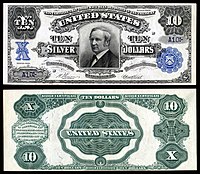
|
Thomas Hendricks | 302 – Vernon and Treat – blue. 303 – Vernon and McClung – blue. |
| $20 | 1878 | Fr.307 | 
|
Stephen Decatur | 305 – 307 305 – Scofield and Gilfillan, CS by J.C. Hopper – large red. |
| $20 | 1880 | Fr.311 | 
|
Stephen Decatur | 308 – 312 308 – Scofield and Gilfillan, CS by T. Hillhouse – large brown. |
| $20 | 1886 | Fr.316 | 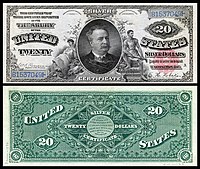
|
Daniel Manning | 313 – Rosecrans and Hyatt – large red. 314 – Rosecrans and Huston – large brown. |
| $20 | 1891 | Fr.317 | 
|
Daniel Manning | |
| $50 | 1878 | Fr.324 | 
|
Edward Everett | 323 – 324c 323 – Scofield and Gilfillan, CS by W.C. White* or J.C. Hopper* – large red. |
| $50 | 1880 | Fr.327 | 
|
Edward Everett | |
| $50 | 1891 | Fr.331 | 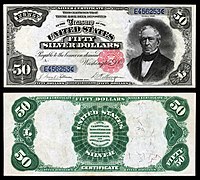
|
Edward Everett | |
| $100 | 1878 | Fr.337b | 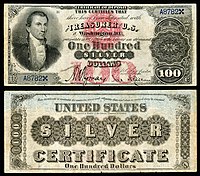
|
James Monroe | 336 – 337b 336 – Scofield and Gilfillan, CS by W.G. White – large red. |
| $100 | 1880 | Fr.340 | 
|
James Monroe | |
| $100 | 1891 | Fr.344 | 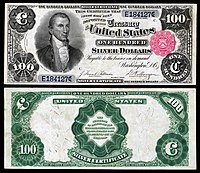
|
James Monroe | 343 – Rosecrans and Nebecker – small red. |
| $500 | 1878 | Fr.345a | 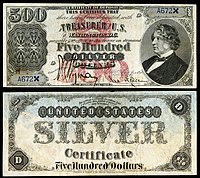
|
Charles Sumner | 345a – Scofield and Gilfillan, CS by A.U. Wyman* – large red, rays. |
| $500 | 1880 | Fr.345c | 
|
Charles Sumner | 345b – Scofield and Gilfillan – large brown. 345c – Bruce and Gilfillan – large brown. |
| $1,000 | 1878 | Fr.346a | 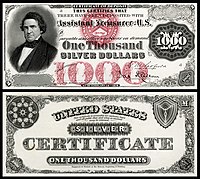
|
William Marcy | 346a – Scofield and Gilfillan, CS unknown – large red, rays. |
| $1,000 | 1880 | Fr.346d | 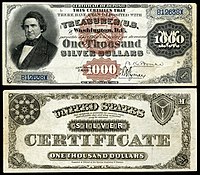
|
William Marcy | 346b – Scofield and Gilfillan – large brown. 346c – Bruce and Gilfillan – large brown. |
| $1,000 | 1891 | Fr.346e | 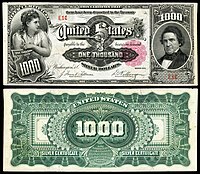
|
William Marcy | 346e – Tillman and Morgan – small red. |
Small-size United States silver certificates (1928-1957)
[edit]| Value | Series | Fr.[nb 7] | Image | Portrait | Signature & seal varieties |
|---|---|---|---|---|---|
| $1 | 1928 to 1928-E | Fr.1600 | 
|
George Washington | |
| $1 | 1934 | Fr.1606 | 
|
George Washington | 1606 – Julian and Morgenthau (1934) – blue. |
| $1 | 1935 to 1935-G | Fr.1607 | 
|
George Washington | 1607 – 1616 1607 – Julian and Morgenthau (1935) – blue. |
| $1 | 1935-G to 1957-B | Fr.1619 | 
|
George Washington | |
| $5 | 1934 to 1934-D | Fr.1650 | 
|
Abraham Lincoln | 1650 – 1654 1650 – Julian and Morgenthau (1934) – blue. |
| $5 | 1953 to 1953-C | Fr.1655 | 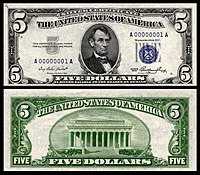
|
Abraham Lincoln | 1655 – Priest and Humphrey (1953) – blue. 1656 – Priest and Anderson (1953A) – blue. |
| $10 | 1933 to 1933-A | Fr.1700 | 
|
Alexander Hamilton | 1700 – Julian and Woodin (1933) – blue.[nb 12]
1700a – Julian and Morgenthau (1933A) – blue.[nb 13] |
| $10 | 1934 to 1934-D | Fr.1701 | 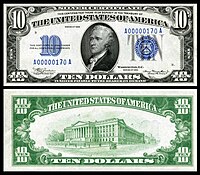
|
Alexander Hamilton | 1701 – 1705 1701 – Julian and Morgenthau (1934) – blue. |
| $10 | 1953 to 1953-B | Fr.1706 | 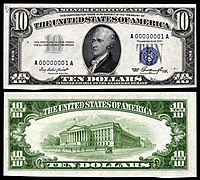
|
Alexander Hamilton | 1706 – Priest and Humphrey (1953) – blue. 1707 – Priest and Anderson (1953A) – blue. |
| $1 | 1935-A | Fr.2300 | 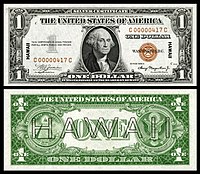
|
George Washington | 2300 – Julian and Morgenthau – brown. |
| $1 | 1935-A | Fr.2306 | 
|
George Washington | 2306 – Julian and Morgenthau (1935A) – yellow. |
| $5 | 1934-A | Fr.2307 | 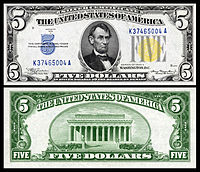
|
Abraham Lincoln | 2307 – Julian and Morgenthau (1934A) – yellow. |
| $10 | 1934 to 1934-A | Fr.2309 | 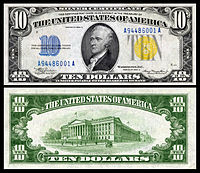
|
Alexander Hamilton | 2308 – Julian and Morgenthau (1934) – yellow. 2309 – Julian and Morgenthau (1934A) – yellow. |
See also
[edit]References
[edit]Footnotes
[edit]- ^ Some have suggested that the bimetallic standard was actually initiated by Thomas Jefferson.[13]
- ^ Although the exact monthly purchase was left to the discretion of the Secretary of the Treasury, the $2 million minimum was never exceeded.[22]
- ^ “The act of February 28, 1878, also authorized the holder of these silver dollars to deposit: the same with the Treasurer, or any Assistant Treasurer, of the United States, in sums not less than ten dollars, and receive therefor certificates of not less than ten dollars each, corresponding with the denominations of the United States notes.”[23]
- ^ “SEC. 2. The Secretary of the Treasury shall maintain the ownership and the possession or control within the United States of an amount of silver of a monetary value equal to the face amount of all outstanding silver certificates. Unless the market price of silver exceeds its monetary value, the Secretary of the Treasury shall not dispose of any silver held or owned by the United States in excess of that required to be held as reserves against outstanding silver certificates, but any such excess silver may be sold to other departments and agencies of the Government or used for the coinage of standard silver dollars and subsidiary silver coins. Silver certificates shall be exchangeable on demand at the Treasury of the United States for silver dollars or, at the option of the Secretary of the Treasury, at such places as he may designate, for silver bullion of a monetary value equal to the face amount of the certificates”.[38]
- ^ "Fr" numbers refer to the numbering system in the widely-used Friedberg reference book. Fr. numbers indicate varieties existing within a larger type design.[42]
- ^ Varieties are presented by Fr. number followed by the specific differences in signature combination, seal (color, size, and style), and minor design changes, if applicable. For Series 1878 notes, an asterisk following the Assistant Treasurer’s name indicates it is hand-signed versus engraved.
- ^ Because small-size silver certificates are presented in ascending Friedberg number, World War II emergency issue notes (2300, 2306, 2307, and 2309) are presented out of chronological order at the end of the table.
- ^ Serial blocks of the 1928A and 1928B silver certificates that were lettered XB or YB were made of experimental paper, and ZB of regular paper as a control.[citation needed]
- ^ Series 1935A "Experimental" bills were stamped with either a red "R" or "S" while testing regular and synthetic papers.[7]
- ^ The motto (“In God We Trust”) was added to the Series of 1935G notes midway through the issue.[7]
- ^ Printed but not issued.[citation needed]
- ^ Very few Series 1933 $10 Silver Certificates were released before they were replaced by Series 1934 and most of those remaining were consigned to destruction; only a few dozen are known to collectors today.[citation needed]
- ^ Printed but not issued.[citation needed]
Notes
[edit]- ^ a b c d Silver Certificates, Bureau of Engraving and Printing/ Treasury Website, retrieved 12 February 2014
- ^ a b Leavens, p. 24.
- ^ Blake, p. 18.
- ^ a b c d Friedberg & Friedberg, p. 74.
- ^ a b Knox, p. 155.
- ^ Friedberg & Friedberg, p. 185.
- ^ a b c Friedberg & Friedberg, p. 187.
- ^ Friedman, p. 1166.
- ^ O’Leary, p. 392.
- ^ a b Barnett, p. 178.
- ^ Friedman, p. 1165.
- ^ Lee, p. 388.
- ^ Carothers, p. 5.
- ^ O’Leary, p. 388.
- ^ Leavens, p. 36.
- ^ Taussig, 1892, p. 11.
- ^ Leavens, p. 38.
- ^ Lee, p. 393.
- ^ a b Lee, p. 396.
- ^ Agger, p. 262.
- ^ a b c Knox, p. 153.
- ^ Taussig, 1892, p. 8.
- ^ Knox, p. 152.
- ^ Taussig, 1892, p. 15.
- ^ Taussig, 1892, p. 10.
- ^ Taussig, 1892, p. 16.
- ^ Champ & Thomson, p. 12.
- ^ McVey, p. 438.
- ^ Champ & Thomson, p. 14.
- ^ a b Leavens, p. 39.
- ^ a b Schwarz & Lindquist, p. 9.
- ^ a b c d BEP History, Bureau of Engraving and Printing/ Treasury Website, retrieved 14 February 2014
- ^ a b Schwartz & Lindquist, p. 24.
- ^ Cuhaj, p. 133.
- ^ a b Dillon, p.401.
- ^ a b Ascher, p. 99.
- ^ a b Dillon, p.400.
- ^ a b c Public Law 88-36 (An Act to repeal certain legislation relating to the purchase of silver, and for other purposes) (PDF) (Report). U.S. Government Printing Office. 1963. Retrieved 14 February 2014.
- ^ Grey, p. 83.
- ^ Blake, p. 19.
- ^ Annual Report of the Secretary of the Treasury on the State of the Finances (Report). United States Department of the Treasury. 1892. p. 475. Retrieved 16 February 2014.
- ^ Friedberg & Friedberg
Books & Journals
[edit]- Agger, Eugene E. (1918). "The Denominations of the Currency". The Quarterly Journal of Economics. 32 (2). Oxford University Press: 257–277. Retrieved 27 January 2014.
- Ascher, Leonard W. (1964). "The Coming Chaos in Our Coinage". Financial Analysts Journal. 20 (3). CFA Institute: 99–102. Retrieved 14 February 2014.
- Barnett, Paul (1964). "The Crime of 1873 Re-examined". Agricultural History. 38 (3). Agricultural History Society: 178–181. Retrieved 27 January 2014.
- Blake, George Herbert (1908). United States paper money. George H. Blake.
{{cite book}}: Cite has empty unknown parameter:|book=(help) - Carothers, Neil (1932). "A Senate Racket". The North American Review. 233 (1). University of Northern Iowa: 4–15. Retrieved 12 February 2014.
- Cuhaj, George S. (2012). Standard Catalog of United States Paper Money. Krause Publications. ISBN 978-1-4402-3087-5. Retrieved 14 February 2014.
- Dillon, C. Douglas (1963). Annual Report of the Secretary of the Treasury on the State of the Finances (PDF) (Report). United States Government Printing Office. pp. 400–403. Retrieved 15 February 2014.
- Friedberg, Arthur L.; Friedberg, Ira S. (2013). Paper Money of the United States: A Complete Illustrated Guide With Valuations (20th ed.). Coin & Currency Institute. ISBN 978-0-87184-520-7. Retrieved 14 February 2014.
- Friedman, Milton (1990). "The Crime of 1873". Journal of Political Economy. 98 (6). The University of Chicago Press: 1159–1194. Retrieved 27 January 2014.
- Grey, George B. (2002). Federal Reserve System: Background, Analyses and Bibliography. Nova Science Publishers, Inc. ISBN 1-59033-053-6. Retrieved 14 February 2014.
- Knox, John Jay (1888). United States Notes: A history of the various issues of paper money by the government of the United States (3rd ed.). Charles Scribner’s Sons.
{{cite book}}: Cite has empty unknown parameter:|book=(help) - Leavens, Dickson H. (1939). Silver Money. Principia Press, Inc. Retrieved 13 February 2014.
- Lee, Alfred E. (1886). "Bimetalism in the United States". Political Science Quarterly. 1 (3). The Academy of Political Science: 386–399. Retrieved 27 January 2014.
- McVey, Frank L. (1902). "The Reclassification of the Paper Currency". Journal of Political Economy. 10 (3). The University of Chicago Press: 437–442. Retrieved 11 June 2013.
- O’Leary, Paul M. (1960). "The Scene of the Crime of 1873 Revisited: A Note". Journal of Political Economy. 68 (4). The University of Chicago Press: 388–392. Retrieved 6 February 2014.
- Schwartz, John; Lindquist, Scott (2011). Standard Guide to Small-Size U.S. Paper Money – 1928 to Date. Krause Publications. ISBN 978-1-4402-1703-6. Retrieved 14 February 2014.
- Taussig, F.W. (1890). "The Silver Situation in the United States". The Quarterly Journal of Economics. 4 (3). Oxford University Press: 291–315. Retrieved 11 June 2013.
- Taussig, F.W. (1892). "The Silver Situation in the United States". Publication of the American Economic Association. 7 (1). American Economic Association: 7–118. Retrieved 11 June 2013.
